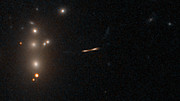Artist’s impression of gas fueling distant starburst galaxies
ALMA view of the Cosmic Eyelash
Videos
How CH+ traces energy can be thought of by
analogy to being on a boat in a tropical ocean on a dark, moonless
night. When the conditions are right, fluorescent plankton can light up
around the boat as it sails. The turbulence caused by the boat sliding
through the water excites the plankton to emit light, which reveals the
existence of the the turbulent regions in the underlying dark water.
Since CH+ forms exclusively in small areas where turbulent
motions of gas dissipates, its detection in essence traces energy on a
galactic scale.
The observed CH+ reveals dense shock waves,
powered by hot, fast galactic winds originating inside the galaxies’
star forming regions. These winds flow through a galaxy, and push
material out of it, but their turbulent motions are such that part of
the material can be re-captured by the gravitational pull of the galaxy
itself. This material gathers into huge turbulent reservoirs of cool,
low-density gas, extending more than 30 000 light-years from the
galaxy’s star forming region [4].
“With CH+, we learn that energy is stored
within vast galaxy-sized winds and ends up as turbulent motions in
previously unseen reservoirs of cold gas surrounding the galaxy,” said Falgarone, who is lead author of the new paper. “Our
results challenge the theory of galaxy evolution. By driving turbulence
in the reservoirs, these galactic winds extend the starburst phase
instead of quenching it.”
The team determined that galactic winds alone could not
replenish the newly revealed gaseous reservoirs and suggests that the
mass is provided by galactic mergers or accretion from hidden streams of
gas, as predicted by current theory.
“This discovery represents a major step forward in our
understanding of how the inflow of material is regulated around the most
intense starburst galaxies in the early Universe,” says ESO’s Director for Science, Rob Ivison, a co-author on the paper. “It
shows what can be achieved when scientists from a variety of
disciplines come together to exploit the capabilities of the world's
most powerful telescope.”
Notes
[1] CH+ is an ion of the CH molecule known as methylidynium
to chemists. It is one of the first three molecules ever discovered in
the interstellar medium. Since its discovery in the early 1940s, the
presence of CH+ in interstellar space has been a mystery
because it is extremely reactive and hence disappears more quickly than
other molecules.
[3] ALMA was used to obtain spectra of each galaxy. A spectrum is a record of light, typically of an astronomical object, split into its different colours (or wavelengths), in much the same way that rain droplets disperse light to form a rainbow. Since every element has a unique “fingerprint” in a spectrum, spectra can be used to determine the chemical composition of observed objects.
[4] These turbulent reservoirs of diffuse gas may be of the same nature as the giant glowing haloes seen around distant quasars.
More Information
This research was presented in a paper entitled “Large
turbulent reservoirs of cold molecular gas around high redshift
starburst galaxies” by E. Falgarone et al., to appear in Nature on 30 August 2017.
The team is composed of E. Falgarone (Ecole Normale
Supérieure and Observatoire de Paris, France), M.A. Zwaan (ESO,
Germany), B. Godard (Ecole Normale Supérieure and Observatoire de Paris,
France), E. Bergin (University of Michigan, USA), R.J. Ivison (ESO,
Germany; University of Edinburgh, UK), P. M. Andreani (ESO, Germany), F.
Bournaud (CEA/AIM, France), R. S. Bussmann (Cornell University, USA),
D. Elbaz (CEA/AIM, France), A. Omont (IAP, CNRS, Sorbonne Universités,
France), I. Oteo (University of Edinburgh, UK; ESO, Germany) and F.
Walter (Max-Planck-Institut für Astronomie, Germany).
ALMA construction and operations are led by ESO on behalf of its Member States; by the National Radio Astronomy Observatory (NRAO), managed by Associated Universities, Inc. (AUI), on behalf of North America; and by the National Astronomical Observatory of Japan (NAOJ) on behalf of East Asia. The Joint ALMA Observatory (JAO) provides the unified leadership and management of the construction, commissioning and operation of ALMA.
ESO is the foremost intergovernmental astronomy
organisation in Europe and the world’s most productive ground-based
astronomical observatory by far. It is supported by 16 countries:
Austria, Belgium, Brazil, the Czech Republic, Denmark, France, Finland,
Germany, Italy, the Netherlands, Poland, Portugal, Spain, Sweden,
Switzerland and the United Kingdom, along with the host state of Chile.
ESO carries out an ambitious programme focused on the design,
construction and operation of powerful ground-based observing facilities
enabling astronomers to make important scientific discoveries. ESO also
plays a leading role in promoting and organising cooperation in
astronomical research. ESO operates three unique world-class observing
sites in Chile: La Silla, Paranal and Chajnantor. At Paranal, ESO
operates the Very Large Telescope and its world-leading Very Large
Telescope Interferometer as well as two survey telescopes, VISTA working
in the infrared and the visible-light VLT Survey Telescope. ESO is also
a major partner in two facilities on Chajnantor, APEX and ALMA, the
largest astronomical project in existence. And on Cerro Armazones, close
to Paranal, ESO is building the 39-metre Extremely Large Telescope, the
ELT, which will become “the world’s biggest eye on the sky”.
Links
Contacts
Links
Contacts
Edith Falgarone
Ecole Normale Supérieure — Observatoire de Paris
Paris, France
Tel: +33 01 4432 3347
Email: edith.falgarone@ens.fr
Richard Hook
ESO Public Information Officer
Garching bei München, Germany
Tel: +49 89 3200 6655
Cell: +49 151 1537 3591
Email: rhook@eso.org
Ecole Normale Supérieure — Observatoire de Paris
Paris, France
Tel: +33 01 4432 3347
Email: edith.falgarone@ens.fr
Richard Hook
ESO Public Information Officer
Garching bei München, Germany
Tel: +49 89 3200 6655
Cell: +49 151 1537 3591
Email: rhook@eso.org
Source: ESO/News


